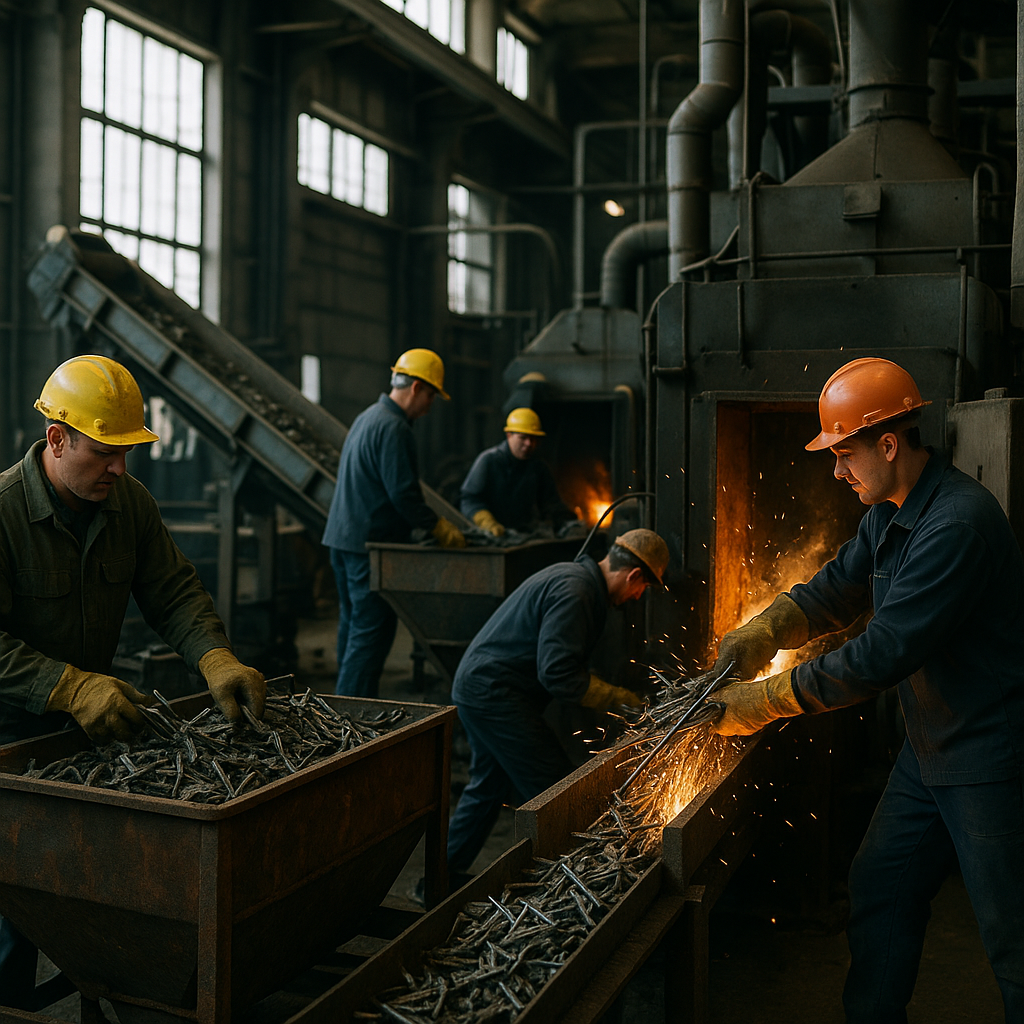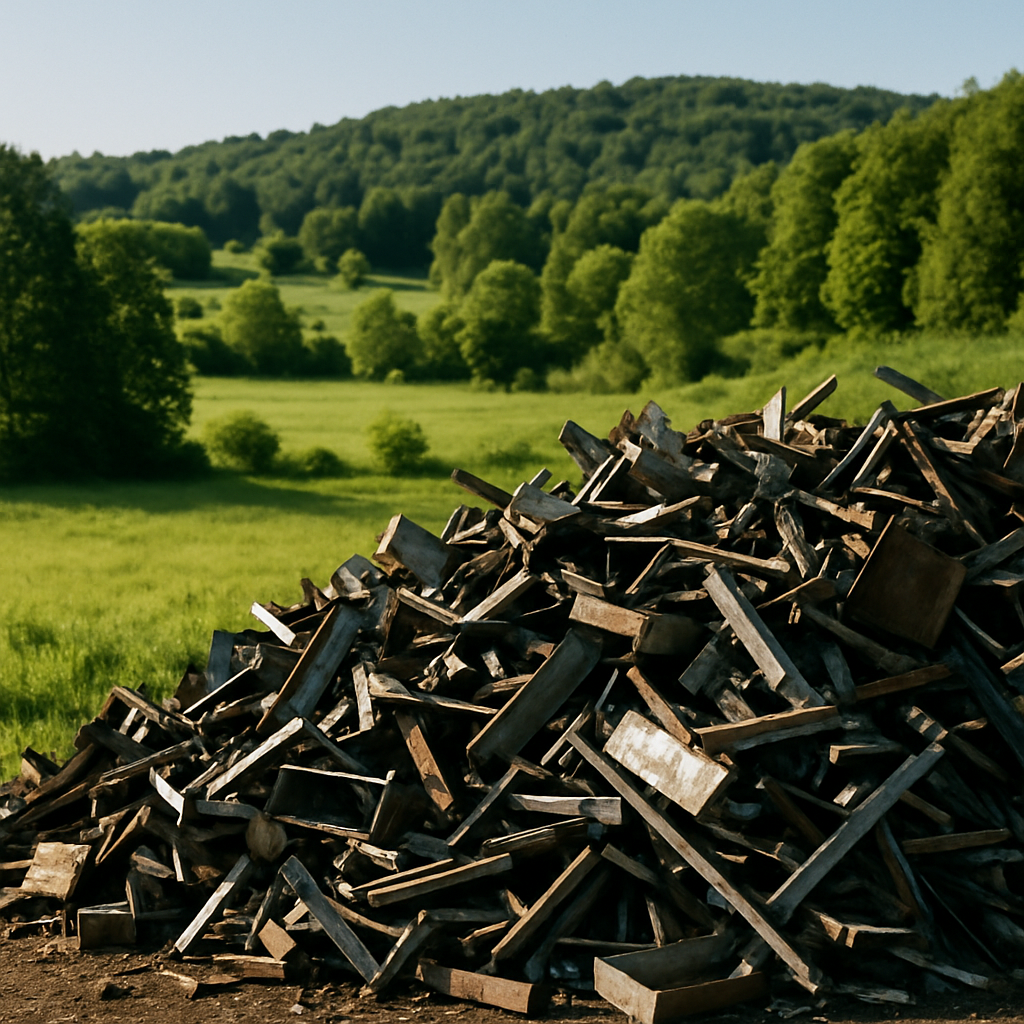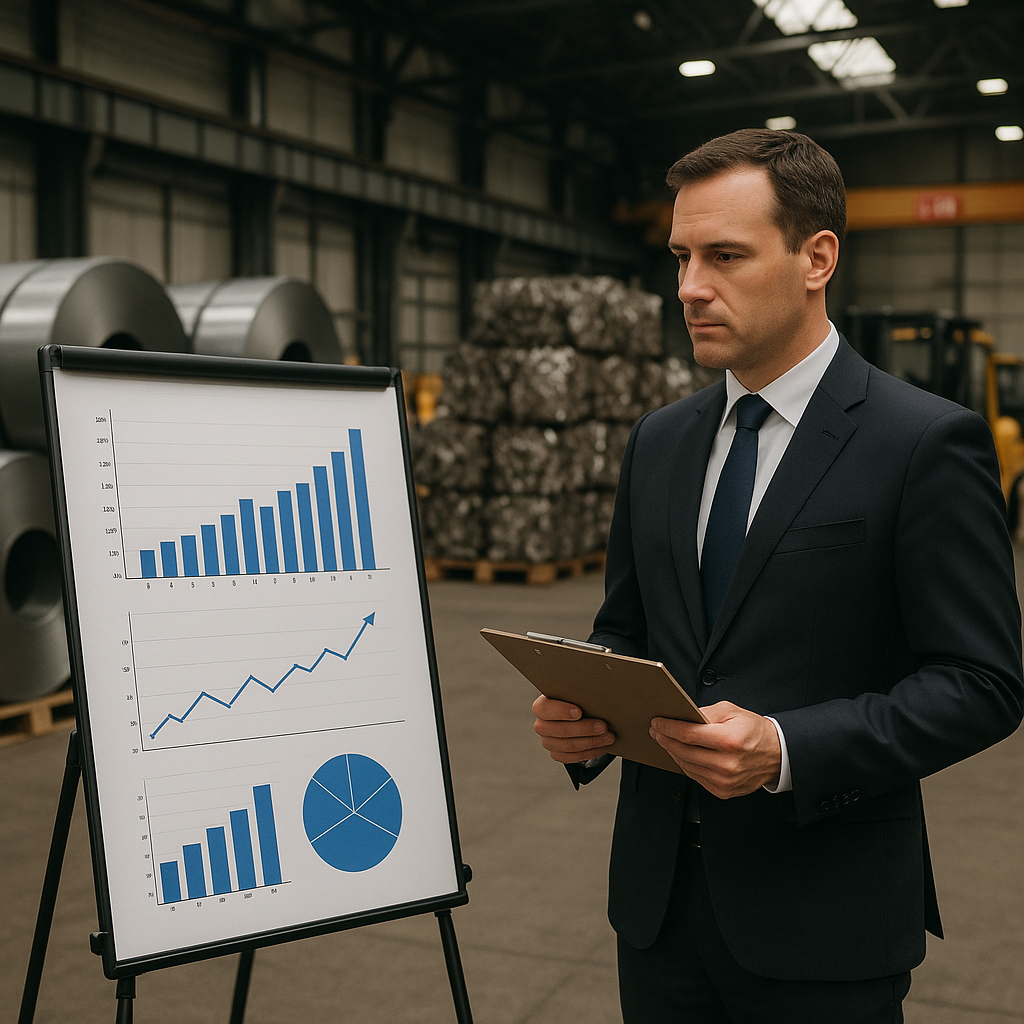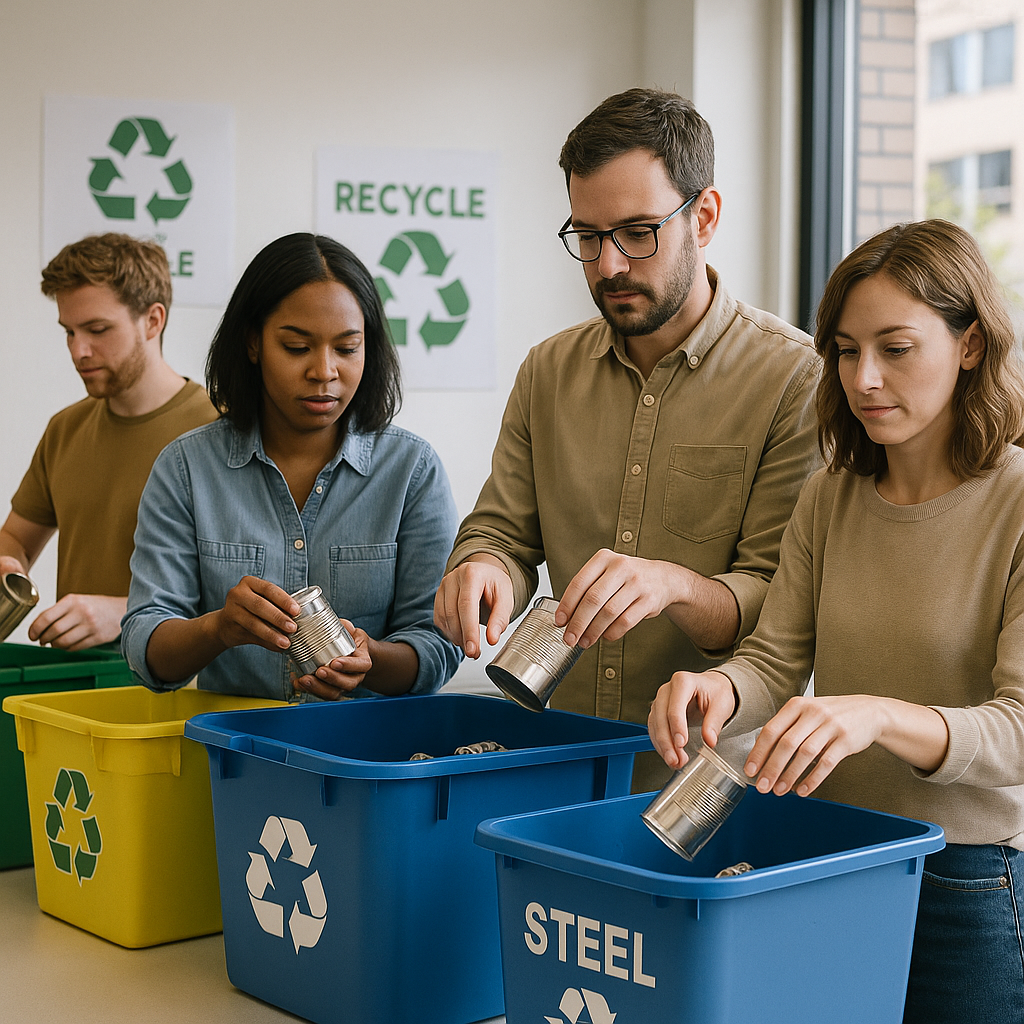5901 Botham Jean Blvd, Dallas, TX 75215
Steel Metal Recycling: How It Works, Why It Matters, and How to Start a Program
September 24, 2025Steel recycling involves collecting, sorting, and reprocessing scrap steel to produce new steel products. It is a cornerstone of sustainability in the steel industry, conserving natural resources, reducing energy consumption, and minimizing waste. Steel is among the most recycled materials in North America, with over 60% recycled annually since 1970.
Whenever you see a construction site with steel beams or drive a car with steel components, you may be interacting with recycled steel. The process transforms everything from old appliances and vehicle parts to construction debris into valuable resources that manufacturers can repeatedly use without quality degradation.
The significance of steel recycling goes beyond straightforward resource recovery. It plays a crucial role in the circular economy by keeping materials in productive use, reducing the need for environmentally damaging mining operations, and cutting greenhouse gas emissions that contribute to climate change.
How Does the Steel Recycling Process Work?

Steel recycling transforms discarded metal into valuable new products through a well-defined sequence of operations. This process conserves natural resources and reduces energy consumption compared to producing steel from raw materials. Let’s examine each step in detail.
Collection of Steel Scrap
The recycling journey begins with collection. Scrap steel comes from three primary sources: home scrap generated within steel mills, industrial scrap from manufacturing facilities, and obsolete scrap from discarded consumer products and structures. Collection methods range from designated drop-off points to buy-back centers that offer compensation for scrap metal.
Steel scrap can include everything from food cans and kitchen appliances to construction materials and automotive parts. The steel industry’s commitment to recycling has made it North America’s most recycled material, with over 60 percent of steel being recycled annually since 1970.
Sorting and Separation
Once collected, the scrap undergoes sorting to ensure quality and remove contaminants. Specialized magnetic equipment separates ferrous metals (containing iron) from non-ferrous materials. This magnetic separation process is crucial for producing high-quality recycled steel.
Sorting is essentially the quality control phase of the recycling process. Some steel items might contain non-recyclable content that could lower the quality of the finished product. The goal is to achieve recyclable content of at least 50 percent metal.
Processing and Compacting
After sorting, the steel scrap is processed using specialized machines that compress and compact the metal. This reduces volume and makes the recycling process more efficient. The compacted steel takes up less space on conveyor belts and requires less energy to melt.
For larger scrap items like vehicles or appliances, industrial shredders may break them into manageable pieces before compacting. This processing stage helps optimize the subsequent phases of recycling.
Shredding Into Smaller Pieces
The compacted steel is then shredded into small pieces or sheets. This step is critical, as smaller pieces melt more easily and require less energy to process. Shredding equipment varies depending on the type of steel being recycled, but the goal remains the same: to create uniform, small pieces that facilitate efficient melting.
This phase exemplifies the environmental benefits of steel recycling, as breaking down the material into smaller components reduces the energy needed for further processing.
Melting in Furnaces
The shredded steel enters a melting phase, where it’s placed in large furnaces and heated to temperatures approaching 3,000 degrees Fahrenheit. Modern steel recycling facilities often use electric arc furnaces (EAFs), which are more energy-efficient than traditional blast furnaces used for producing steel from iron ore.
Different varieties of steel are typically placed in separate furnaces to maintain quality control. The smelting process converts the solid pieces into molten metal, with the duration varying from minutes to hours depending on the quantity and composition of the steel.
Purification Process
After melting, the molten steel undergoes purification to remove impurities and contaminants. Various methods, including electrolysis, distillation, zone refining, and chromatography, may be employed to ensure the final product meets quality standards.
Purification is crucial for maintaining the structural integrity of the recycled steel. It removes dirt, debris, and other substances that could compromise the final product’s strength and durability. This attention to quality ensures that recycled steel performs as well as newly manufactured steel.
Solidification Into New Products
In the final stage, the purified molten steel is transferred to cooling containers where it solidifies. Advanced systems move the hot metal from heating chambers to cooling areas, and chemical compounds help stabilize the molten steel to maintain its desired properties.
The steel is shaped into various forms such as structural steel, bar stock, pipes, or sheets. These new steel products retain all the properties of virgin steel and can be used across multiple industries—from construction and automotive to appliances and packaging. The solidified steel is then ready for shipment to manufacturers who will transform it into new products.
What makes steel recycling particularly valuable is that steel can be recycled repeatedly without degrading in quality. This infinite recyclability makes steel a true champion of the circular economy, where materials are continuously reused rather than discarded.
What Are the Environmental Benefits of Steel Recycling?

Steel recycling delivers impressive environmental benefits by conserving substantial resources. Each ton of recycled steel saves approximately 2,500 pounds of iron ore, 1,400 pounds of coal, and 120 pounds of limestone, protecting finite raw materials and reducing environmentally damaging mining operations.
Energy efficiency is another significant advantage of steel recycling. The process requires 75% less energy compared to producing steel from virgin materials, saving about 16-19 gigajoules per ton of steel produced. This decreases strain on power grids and lessens dependence on fossil fuels.
Reducing CO2 emissions is another vital environmental benefit. Steel recycling generates 70-80% fewer carbon dioxide emissions than conventional production methods. Recycling one ton of steel instead of using raw materials prevents approximately 1.5 tons of carbon dioxide from entering the atmosphere, helping combat climate change on a global scale.
The steel recycling process also contributes to significant water conservation, requiring 40-50% less water compared to primary production methods. This results in a savings of 50-60 cubic meters of water per ton of steel produced, a crucial benefit in regions facing water scarcity.
Diverting steel from landfills creates additional environmental benefits by preventing soil and groundwater contamination and preserving valuable landfill space. Each ton of recycled steel prevents approximately 2 tons of waste from entering landfills.
Steel recycling supports the principles of a circular economy, where materials are kept in use indefinitely. Unlike many materials that degrade during recycling, steel maintains its essential properties regardless of how many times it is reused. This perfect circularity makes steel ideal for sustainable material cycles and continuous reuse.
What Are the Economic Impacts of Steel Recycling?

Steel recycling provides significant economic benefits across various sectors. Manufacturing companies see considerable cost reductions by using recycled steel instead of virgin materials. This cost advantage arises from bypassing the costly processes of extracting and refining raw ore, which demand substantial energy and resources.
The economic impact of steel recycling goes beyond savings in manufacturing. According to the American Iron and Steel Institute, the industry supports over 531,000 jobs nationwide and generates more than $110 billion in economic activity annually, making it a crucial part of the U.S. economy and job market.
Job Creation and Economic Growth
The steel recycling sector creates jobs at various levels, requiring workers for collection, sorting, processing, and manufacturing recycled steel products. These roles span diverse skill levels, from basic collection and transportation to advanced processing positions.
Employment extends beyond direct recycling operations, supporting countless indirect positions in equipment manufacturing, transportation, and service industries that aid recycling facilities. Each job spurs local economic growth and strengthens communities.
The Institute of Scrap Recycling Industries indicates the broader recycling industry contributes approximately $5 billion in tax revenue to state and local governments annually, supporting essential community services and infrastructure improvements.
Revenue Generation Through Scrap Sales
Businesses generating steel waste gain a valuable revenue stream through recycling. Instead of incurring disposal fees, companies can sell their scrap steel to recyclers. Manufacturing facilities, construction companies, and automotive shops often recover substantial value from materials that might otherwise be discarded.
Even individuals can financially benefit from recycling steel. Items such as appliances, metal furniture, and construction materials contain valuable steel that recyclers will buy, offering a financial incentive for responsible disposal.
Cost Reduction for Manufacturers
Using recycled steel significantly reduces production expenses. Recycling steel saves about 75% of the energy needed to produce steel from raw materials, directly lowering manufacturing costs and enhancing pricing competitiveness for finished products.
Cost efficiency extends beyond energy savings, as recycled steel reduces the need for mining, raw material transportation, and processing of virgin ores. This comprehensive advantage makes recycled steel an economically appealing option for manufacturers in various industries.
Steel’s infinite recyclability means it can be reprocessed repeatedly without losing quality, creating a sustainable, cost-effective material supply chain that benefits manufacturers over the long term. Unlike some other recyclable materials, steel maintains its structural integrity through multiple recycling cycles.
Market Growth and Global Trade
The steel recycling industry significantly contributes to international trade. The U.S. is a major exporter of recycled steel, generating billions in revenue. This international demand for recycled steel fosters additional market opportunities and economic benefits.
As global sustainability efforts increase, the demand for recycled steel grows, creating new business opportunities and driving innovation in recycling technologies. Companies investing in steel recycling infrastructure position themselves for future growth in this expanding sector.
How Can Businesses Implement Effective Steel Recycling Programs?

Implementing an effective steel recycling program requires strategic planning and consistent execution. Businesses that develop comprehensive recycling initiatives reduce their environmental footprint and create opportunities for cost savings and revenue generation.
Conduct a Thorough Waste Audit
Before launching a steel recycling program, businesses should perform a detailed waste audit. This process involves examining the waste stream to identify discarded steel materials and their quantities.
A comprehensive audit helps quantify potential recyclable materials and establishes baseline metrics for measuring program success. Businesses often discover that up to 30% of their waste stream consists of recyclable metals previously sent to landfills.
Document findings in a standardized format and conduct quarterly audits to account for seasonal variations in waste generation. These regular assessments reveal trends and opportunities for process improvements.
Establish Strategic Collection Systems
Once you understand your metal waste profile, implement efficient collection infrastructure throughout your facility. Place clearly labeled collection points in areas where metal waste is commonly generated.
For manufacturing environments, position containers near production lines where scrap is generated. Use visual cues and simple instructions to help employees identify which metals belong in which containers.
Separate ferrous metals from non-ferrous metals to increase the value of recyclable materials. Consider using magnetic separators for easier identification of steel and other ferrous materials.
Partner with Specialized Recycling Companies
Selecting the right recycling partner significantly impacts program success. Look for companies that specialize in handling steel and other metals your business generates. The ideal partner offers transparent pricing, reliable scheduling, and documentation that tracks your environmental impact.
When evaluating potential partners, assess their processing capabilities, environmental compliance record, and industry reputation. Many leading recyclers offer additional services like waste audits, equipment loans, and customized collection solutions.
These value-added services can enhance your recycling program without requiring additional capital investment. Establish clear communication channels with your chosen recycler to ensure timely pickups and minimize operational disruptions.
Invest in Employee Education
Your recycling program is only as effective as the people participating in it. Comprehensive employee training ensures everyone understands what materials can be recycled and how to prepare them properly.
Training should cover basic identification of different metal types, proper handling procedures, and contamination prevention. Regular workshops keep recycling practices top of mind and address emerging questions or challenges.
Consider integrating recycling training into new employee onboarding and provide quarterly refreshers for all staff. Create visual guides showing examples of recyclable metals relevant to your operations to boost compliance.
Consider Equipment Investments
Depending on the volume of steel waste generated, businesses may benefit from investing in specialized equipment. For high-volume operations, balers and compactors can reduce storage requirements and transportation costs.
Smaller operations might only need properly labeled collection bins. Evaluate equipment based on your specific needs, considering factors like maintenance requirements, operational costs, and safety features.
Equipment that appears cheaper upfront might ultimately cost more due to frequent repairs or higher energy consumption. Choose machinery with good warranties and reliable customer support.
Track and Report Your Impact
Implement comprehensive tracking systems to measure success and identify improvement opportunities. Key metrics include total weight recycled, percentage of waste diverted from landfills, and cost savings achieved.
Request monthly tonnage reports from your recycling partner detailing the amounts of steel and other materials collected. These metrics help demonstrate environmental commitment to stakeholders and customers.
Consider calculating environmental benefits of your recycling program in terms of energy saved, greenhouse gas emissions avoided, and virgin resources conserved. These tangible metrics help communicate the importance of your efforts to employees and external stakeholders.
Optimize Transportation Logistics
Transportation represents a significant cost in recycling programs. Schedule pickups based on your waste generation patterns to minimize these expenses. Consider compacting materials when appropriate to reduce volume and transportation frequency.
For businesses with multiple locations, explore consolidated pickups that service several facilities in a single route. This approach reduces transportation costs and minimizes the carbon footprint associated with your recycling program.
Work with your recycling partner to determine the most efficient container sizes for your volume. Right-sizing your containers prevents unnecessary pickups while avoiding overflow issues that create workplace hazards.
By implementing these strategies, businesses can transform their steel recycling programs into valuable sustainability initiatives that deliver environmental benefits while potentially generating revenue from materials that would otherwise become waste.
Conclusion: The Future of Steel Metal Recycling
Steel recycling is essential for establishing a sustainable, circular economy in the metal industry. Transforming scrap steel into new products conserves finite natural resources and reduces energy consumption by up to 75% compared to producing virgin materials. This process also significantly cuts greenhouse gas emissions, with each ton of recycled steel preventing around 1.5 tons of carbon dioxide from entering the atmosphere.
Looking ahead, technological innovations are transforming the industry. AI-powered sorting systems, advanced material recovery facilities, and blockchain technology for supply chain transparency are enhancing recycling processes’ efficiency. These advancements allow for the recovery of materials as small as 0.2mm, optimizing resource use and driving economic opportunities through job creation and market stability. For your steel recycling needs and to support a more sustainable future, contact Okon Recycling at 214-717-4083.
